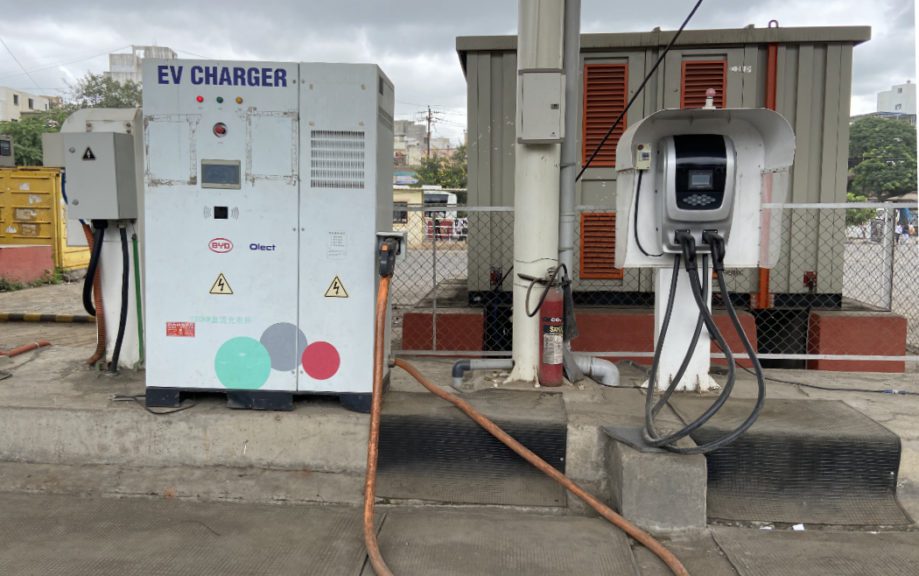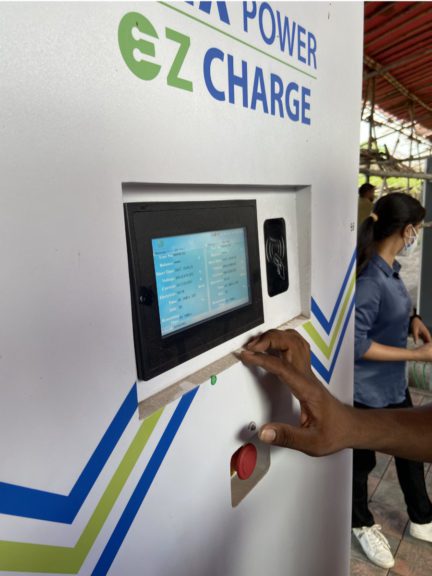Blog
Lessons about charging infrastructure from electric bus operations in Maharashtra
The final blog post in a three-part series about our conversations with authorities in Pune, Mumbai, and Navi Mumbai.
In the previous two posts, I explained how transit authorities are happy with their electric buses and how electric buses have provided multiple benefits. Now that we’ve published our report with details and analysis of my interviews with more than 20 individuals from transit authorities and their private bus operators, I want to use this third post to shine a light on key lessons from their experience with setting up charging infrastructure.

150 kW (left) and 80 kW (right) charging stations in Pune. Photo by Anuj Dhole.
A charging station—sometimes referred to as a charge point or electric vehicle supply equipment (EVSE)—is used to charge electric vehicles. As shown in the photo on the right, it looks like a metal box with one or more charging guns attached to it. It also has a display that shows information about the charging events, such as percentage of battery charged, time elapsed or estimated time remaining, and more. Unsurprisingly, the high-capacity chargers—150 kW and above—that I observed in the three cities were larger in size than the low-capacity ones. Each charging station has a separate electricity meter.
The general practice in Maharashtra is that the transit authorities and the urban local bodies coordinate with the power distribution company to provide the upstream electrical infrastructure needed to support charging stations and the electrical connection up to the electricity meter for each charging station. The cost for this is borne by the urban local bodies. A connection to supply power for the rest of the facilities at a given bus depot, including the office and maintenance workshop, is provided on a separate meter and the monthly bill for that is paid by the private bus operator. Payment of the energy cost for charging the buses depends upon the terms of the bus contract: Pune Mahanagar Parivahan Mahamandal Ltd (PMPML) and Navi Mumbai Municipal Transport (NMMT) pay for the electricity for bus charging separately, while Brihanmumbai Electric Supply and Transport Undertaking (BEST) included this cost in the agreed upon fee payable to the operator in the gross cost contract. (BEST is a unique case where it is itself a power distribution company. BEST uses its own electricity in most depots and purchases electricity from other power distribution companies where BEST’s infrastructure is not available.)
There is a major shift in the electric power load requirements when moving to an electric bus depot from a bus depot for internal combustion engine (ICE) buses. According to the electrical engineer from PMPML, the total load requirement for a depot with only ICE buses is typically between 30 kW and 50 kW, but the power requirement for a single slow electric bus charger that they have deployed is 80 kW. For a single fast charger, it is 150 kW, and a depot with about 90 electric buses might need up to 4 MW (4,000 kW) of sanctioned load from the power distribution company.
The high load requirement requires high-capacity upstream electrical infrastructure, and all interviewees highlighted the importance of meticulous infrastructure planning alongside the procurement process of electric buses. The electrical engineer from PMPML explained that the time required for setting up upstream electrical infrastructure depends upon whether the power distribution company needs to set up a new substation; if a suitable substation is already available, then it depends on how far away it is from the depot. My takeaway was that the transit authorities should be prepared for depot setup to take 6 months. This includes both charging infrastructure setup and depot development.

Display of a charging station in Mumbai. Photo by Anuj Dhole.
I learned that PMPML’s electric bus depots are mainly located at the fringes of the city and the upstream infrastructure had to be newly set up. In PMPML’s experience, the cost of setting up a depot for 100 electric buses can be as high as ₹ 5 crore (50 million), and up to 50% of this cost could go into the security deposit to the power distribution company. The high cost of upstream infrastructure can be justified by its long useful life. For example, transformers last for 25 years and supply cables last for 25 to 35 years. While the infrastructure cost is borne by the urban local bodies, the transit authorities need to pay the security deposit.
The security deposit for the electrical infrastructure depends on the power distribution company. For example, Maharashtra State Electricity Distribution Co. Ltd. calculates the security deposit based on multiple factors: whether the consumer is residential, commercial, industrial, et cetera; contract demand in kW or kVA; load sanctioned to the consumer; load factor; diversity factor; and the number of working shifts of the consumer, which is a way of understanding the total hours of the consumer’s operations. A precise estimation of load requirements can avoid unnecessary/extra sanctioned load and thus minimize the security deposit.
The high load requirement also necessitates some different procedures around safety. PMPML plans to carry out third-party inspections of the electrical infrastructure, including the electric bus chargers, every year to ensure the safety of the staff. NMMT highlighted the importance of weather protection for the charging stations, such as canopies that cover them from rain, and optimal drainage around the depot to avoid water logging.
I learned from a depot manager at PMPML that power failures are uncommon, but still something to be aware of. An arrangement with power distribution companies for special infrastructure like express feeders can help minimize power failures. An express feeder involves the installation of an exclusive feeder for an electric bus depot at the nearest substation. PMPML is a bulk customer because of the high energy demand of its electric bus depots, and thus the power distribution company responds quickly in the case of power failures. The manager also highlighted that private bus operators have learned from experience that power failures are more common on certain days of the week, as a result of the power distribution company’s scheduled maintenance, and so they plan their charging schedules accordingly to minimize the impact on bus operations.
The individuals I interviewed have overseen the deployment of over 700 electric buses so far in their varying roles, all of which are important. Electric buses are changing the landscape of bus operations in India and around the world and that’s really good news, because this technology has the potential to dramatically improve air quality in our cities.
This is part of NDC Transport Initiative for Asia (NDC-TIA). NDC-TIA is part of the International Climate Initiative (IKI). IKI is working under the leadership of the Federal Ministry for Economic Affairs and Climate Action, in close cooperation with its founder, the Federal Ministry of Environment and the Federal Foreign Office. For more visit: https://www.ndctransportinitiativeforasia.org/.
